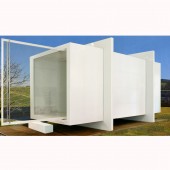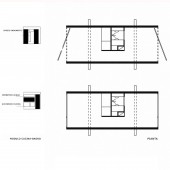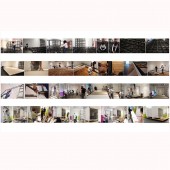
| THE AWARD |
| CATEGORIES |
| REGISTRATION |
| SUBMIT YOUR WORK |
| ENTRY INSTRUCTIONS |
| TERMS & CONDITIONS |
| PUBLICATIONS |
| DATES & FEES |
| METHODOLOGY |
| CONTACT |
| WINNERS |
| PRESS ROOM |
| GET INVOLVED |
| DESIGN PRIZE |
| DESIGN STORE |
| THE AWARD | JURY | CATEGORIES | REGISTRATION | PRESS | WINNERS | PUBLICATIONS | ENTRY INSTRUCTIONS |
Absolute Box Small House Post Disaster by Anna rita Emili |
Home > Winners > Design #29721 >Interview |
 |
|
FS: What is the main principle, idea and inspiration behind your design?
AE: Our architecture can be defined experimental that is we experiment the impact a particular space has on people. Those effects, mainly related to the phenomenological and perceptive aspect, as Merleau Ponty meant, take their inspiration from a series of phenomena inherent to the contemporary reality that influence the conception of the living space by changing the individual behaviour living space is meant both public and private). We are talking about phenomena permeating the urban area (mobility, speed, complexity, etc…), natural phenomena (desertification, floods, earthquakes), or events concerning the whole world which, even interacting with different cultures and races, all share common elements underlined by terms such as information, consumerism, emigration, globalization etc…Our research is therefore intended as a possible response to a series of events, or, in some cases, rather like predictions sometimes approaching utopian solutions. We often wondered how it was possible to reach abstract solutions, forecasting future whether immediate, even starting from real elements.. The answer lies in what we mean by ‘real’ talking about a specific phenomenon.
FS: What has been your main focus in designing this work? Especially what did you want to achieve?
AE: The human body, as well as the architectural one is an hypothesis to be run, for it involves all the fields of knowledge analyzing changes, associations and alienations (whether they are architectural, social, territorial, philosophical, anthropological etc) which the individual inhabits, runs, changes, crosses, far away from home. The house, or the box (as a too generic and banal expression used to indicate the more complex living systems whether they are built in series or just one by one) conceived to satisfy and to protect our being in the world, indeed it can just isolate us taking us away from the surround. Trying to cover the distance a man gets into a cardboard box, in which he cut out a fissure, and walk around the city. "So like a nomad weaving connects his cloth and the house itself to the outer space, to the open space within the body moves". Once he has built his living cloth the man in the box leaves for an exploration travel, that will let him confront with his inner self, with the territory that he marches over, with the geography he draws,. And with the complexity he passes through. “Eppure a me piace moltissimo un paesaggio così a distanze vaghe configurazioni equivoche forse perché assomiglia alla mia condizione. Di qualunque paesaggio non ci si stufa mai a guardarlo da dentro una scatola” (Indeed I like so much such a landascape characterized by vague distances, equivocal configurations, maybe because it is similar to my condition. Never get enough looking at it from a box). K.Abe, Hako Otolo. "L’uomo in scatola" Einaudi
FS: What are your future plans for this award winning design?
AE: to continue to get architecture
FS: How long did it take you to design this particular concept?
AE: I dont' remember
FS: Is your design being produced or used by another company, or do you plan to sell or lease the production rights or do you intent to produce your work yourself?
AE: was a project competition
FS: What made you design this particular type of work?
AE: Being firmly convinced that architecture is a perfect synthesis of science and art, my inspirations are, on one hand, as I said before, the facts determining the reality around us (this finds expression in the use of new techniques and materials), and, on the other hand, the study of the various arts: music, philosophy, literature, but above all the figurative arts. Art has always been the utmost expression of political, cultural and social thought and is typically expressed and developed long before architecture. The knowledge of art as well as an artist’s mindset are essential components of the spirit of an architect. It is this “artist’s mindset” that distinguishes a real architect from a mere technician of architecture. Our ambitions are to look constantly ahead, at the world around us and project it into the future. Our goal is to offer real answers to the kind of problems that increasingly affect the reality we live in. What we are talking about are events affecting the entire planet such immigration, mobility, complexity, etc., or natural phenomena such as desertification, hurricanes, floods, etc., or even computerization, an increasingly fast communication, etc. … Our purpose is to discern, based on social, anthropological, political experience, what will be the developments of future society without omitting near-future scenarios that might be not so optimistic. In that case, our message becomes a warning that cannot be ignored
FS: Where there any other designs and/or designers that helped the influence the design of your work?
AE: no
FS: Who is the target customer for his design?
AE: Various
FS: How did you come up with the name for this design? What does it mean?
AE: The term box, when applied to residences, expressed a living condition that recalls back substantially to traditional methods. Humans have always lived in more less articulated boxes, which have always been more or less open (or closed), and which when configured as organised living places, represent that refuge in which man gathers and expresses the memories of his private world. This condition tends to accentuate the inversely proportional relationship that exists between in and out: the more comfortable is the inner space the less disposed is to the outer one. In fact, since remote times, man has developed increasingly welcoming and comfortable domestic spaces, but which are at the same time increasingly withdrawn from the outside world and thus create an inevitable distance between the individual and the external world and the social relationships. (That however seem to be fundamental given the present living conditions, look at the Greek cities for example). That’s why we propose a housing model which is not the result of a merely aesthetic work, it focuses on the recovery of individual relationships and moves towards new living requirements. We think that the box leads to consider the house exclusively as a refuge, it is an instrument that models itself on the individual, just as a skin and not longer as a domestic space, as for example with animal shells. In this sense it is a provisional shelter that is necessary but at the same time eternal for the person who inhabits the territory.
FS: What is the most unique aspect of your design?
AE: absolute and simply space
FS: Who did you collaborate with for this design? Did you work with people with technical / specialized skills?
AE: With engineer Barbara Pellegrino, sociologist Massimo Ilardi
FS: What is the role of technology in this particular design?
AE: Very important role
FS: Is your design influenced by data or analytical research in any way? What kind of research did you conduct for making this design?
AE: sociological and anthropological research
FS: What are some of the challenges you faced during the design/realization of your concept?
AE: Simply and light construction and technology
FS: Thank you for providing us with this opportunity to interview you.
A' Design Award and Competitions grants rights to press members and bloggers to use parts of this interview. This interview is provided as it is; DesignPRWire and A' Design Award and Competitions cannot be held responsible for the answers given by participating designers.
| SOCIAL |
| + Add to Likes / Favorites | Send to My Email | Comment | View Press-Release |





